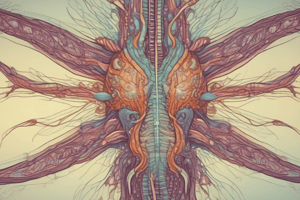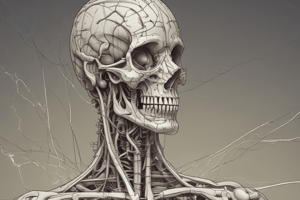Podcast
Questions and Answers
What is the primary role of sympathetic tone in arterioles?
What is the primary role of sympathetic tone in arterioles?
- To constrict systemic arterioles (correct)
- To reduce blood pressure
- To dilate systemic arterioles
- To maintain digestive functions
The vagus nerve increases the intrinsic activity of the sino-atrial node.
The vagus nerve increases the intrinsic activity of the sino-atrial node.
False (B)
What two hormones does sympathetic tone stimulate the secretion of from the adrenal medulla?
What two hormones does sympathetic tone stimulate the secretion of from the adrenal medulla?
Epinephrine and Norepinephrine
The activation of parasympathetic nerves to the penis leads to ________.
The activation of parasympathetic nerves to the penis leads to ________.
Match the following organs with their corresponding ANS division:
Match the following organs with their corresponding ANS division:
Which of the following is an example of dual antagonistic effects?
Which of the following is an example of dual antagonistic effects?
Parasympathetic activation of the salivary glands results in the production of thick, viscous saliva.
Parasympathetic activation of the salivary glands results in the production of thick, viscous saliva.
Which division of the ANS is responsible for stimulating sweat glands?
Which division of the ANS is responsible for stimulating sweat glands?
What is the primary cause of myasthenia gravis?
What is the primary cause of myasthenia gravis?
Pheochromocytoma is characterized by decreased secretion of epinephrine and norepinephrine.
Pheochromocytoma is characterized by decreased secretion of epinephrine and norepinephrine.
What is a main symptom of Horner syndrome?
What is a main symptom of Horner syndrome?
Myasthenia gravis primarily affects the ________ muscles, leading to various symptoms.
Myasthenia gravis primarily affects the ________ muscles, leading to various symptoms.
Which of the following treatments is used for myasthenia gravis?
Which of the following treatments is used for myasthenia gravis?
Match the following conditions with their descriptions:
Match the following conditions with their descriptions:
Raynaud's phenomenon is commonly exacerbated by exposure to heat.
Raynaud's phenomenon is commonly exacerbated by exposure to heat.
What can lead to death in severe cases of myasthenia gravis?
What can lead to death in severe cases of myasthenia gravis?
What is the primary function of the sympathetic nervous system during a stressful situation?
What is the primary function of the sympathetic nervous system during a stressful situation?
The parasympathetic nervous system is primarily responsible for the 'fight or flight' response.
The parasympathetic nervous system is primarily responsible for the 'fight or flight' response.
What is meant by 'dual innervation' in the context of the autonomic nervous system?
What is meant by 'dual innervation' in the context of the autonomic nervous system?
The sympathetic nervous system is also known for its __________ action during stress.
The sympathetic nervous system is also known for its __________ action during stress.
Which of the following is an example of parasympathetic action?
Which of the following is an example of parasympathetic action?
Match the nervous systems to their corresponding actions:
Match the nervous systems to their corresponding actions:
Parasympathetic reflexes usually act on multiple organs at once.
Parasympathetic reflexes usually act on multiple organs at once.
What is the result of increased activity in the sympathetic nervous system?
What is the result of increased activity in the sympathetic nervous system?
Which of the following are symptoms of organophosphate poisoning? (Select all that apply)
Which of the following are symptoms of organophosphate poisoning? (Select all that apply)
Myasthenia gravis is an autoimmune disease.
Myasthenia gravis is an autoimmune disease.
What treatment is commonly used for organophosphate poisoning?
What treatment is commonly used for organophosphate poisoning?
Paralytic ileus is primarily caused by increased __________ activity.
Paralytic ileus is primarily caused by increased __________ activity.
Match the symptoms with their corresponding conditions:
Match the symptoms with their corresponding conditions:
Which option is NOT a treatment for paralytic ileus?
Which option is NOT a treatment for paralytic ileus?
All body organs receive dual innervation of sympathetic and parasympathetic nerves.
All body organs receive dual innervation of sympathetic and parasympathetic nerves.
What are the manifestations of increased arterial blood pressure due to vasoconstriction?
What are the manifestations of increased arterial blood pressure due to vasoconstriction?
Flashcards
Sympathetic Mass Discharge
Sympathetic Mass Discharge
The sympathetic nervous system elicits a widespread response throughout the body, activating various organs in a coordinated manner, like a general alarm.
Parasympathetic Localized Action
Parasympathetic Localized Action
The parasympathetic nervous system often targets specific organs, triggering localized actions, impacting a smaller area.
Sympathetic Tone
Sympathetic Tone
A state of continuous, low-level activity of the sympathetic nervous system, influencing various bodily functions at baseline.
Sympathetic Impact on Heart Rate
Sympathetic Impact on Heart Rate
Signup and view all the flashcards
Parasympathetic Impact on Heart Rate
Parasympathetic Impact on Heart Rate
Signup and view all the flashcards
Parasympathetic 'Rest-and-Digest' Functions
Parasympathetic 'Rest-and-Digest' Functions
Signup and view all the flashcards
Dual Innervation Advantage
Dual Innervation Advantage
Signup and view all the flashcards
Reciprocal Control of Sympathetic and Parasympathetic Systems
Reciprocal Control of Sympathetic and Parasympathetic Systems
Signup and view all the flashcards
What is Myasthenia Gravis?
What is Myasthenia Gravis?
Signup and view all the flashcards
What is Horner Syndrome?
What is Horner Syndrome?
Signup and view all the flashcards
What is Raynaud's Phenomenon?
What is Raynaud's Phenomenon?
Signup and view all the flashcards
What is a Pheochromocytoma?
What is a Pheochromocytoma?
Signup and view all the flashcards
What is Neostigmine used for?
What is Neostigmine used for?
Signup and view all the flashcards
What are Autonomic Disorders?
What are Autonomic Disorders?
Signup and view all the flashcards
Define Myasthenia gravis' 'muscular weakness'
Define Myasthenia gravis' 'muscular weakness'
Signup and view all the flashcards
What is Anhidrosis?
What is Anhidrosis?
Signup and view all the flashcards
Sympathetic Tone in Arterioles
Sympathetic Tone in Arterioles
Signup and view all the flashcards
Sympathetic Tone and Adrenal Medulla
Sympathetic Tone and Adrenal Medulla
Signup and view all the flashcards
Parasympathetic Tone in the Gut
Parasympathetic Tone in the Gut
Signup and view all the flashcards
Vagal Tone on the Heart
Vagal Tone on the Heart
Signup and view all the flashcards
Dual Innervation of the ANS
Dual Innervation of the ANS
Signup and view all the flashcards
Antagonistic Dual Innervation
Antagonistic Dual Innervation
Signup and view all the flashcards
Complementary Dual Innervation
Complementary Dual Innervation
Signup and view all the flashcards
Cooperative Dual Innervation
Cooperative Dual Innervation
Signup and view all the flashcards
Sympathetic Overactivity
Sympathetic Overactivity
Signup and view all the flashcards
Paralytic Ileus
Paralytic Ileus
Signup and view all the flashcards
Organophosphates
Organophosphates
Signup and view all the flashcards
Myasthenia Gravis
Myasthenia Gravis
Signup and view all the flashcards
Horner's Syndrome
Horner's Syndrome
Signup and view all the flashcards
DUMBELS
DUMBELS
Signup and view all the flashcards
Muscarinic Cholinergic Receptor Antagonist
Muscarinic Cholinergic Receptor Antagonist
Signup and view all the flashcards
Surgical Removal of Tumor
Surgical Removal of Tumor
Signup and view all the flashcards
Study Notes
Autonomic Nervous System
- The autonomic nervous system (ANS) controls involuntary functions, such as heart rate and digestion
- It has two branches: sympathetic and parasympathetic
- The sympathetic nervous system prepares the body for "fight-or-flight" responses
- The parasympathetic nervous system promotes "rest-and-digest" responses
Mode of Action of Sympathetic and Parasympathetic Nervous System
- Dual innervation: Many organs receive input from both the sympathetic and parasympathetic systems
- Antagonistic effects: The two systems often have opposing effects. For example, sympathetic nerves increase heart rate while parasympathetic nerves decrease it
- Cooperative effects: Sometimes, the two systems work together to achieve a coordinated response. For example, both systems contribute to salivation, though sympathetic saliva is thick and parasympathetic saliva is watery
- Complementary effects: Both systems may stimulate an organ simultaneously, each in its own way. While in some instances one system has a strong effect, the other system's effect might be subtle, but it is still there
- Sympathetic tone: The continuous activity of the sympathetic system helps maintain a baseline level of blood pressure and other functions.
- Parasympathetic tone: The continuous activity of the parasympathetic system helps maintain normal functions in many organs, such as digestion
- Localized actions: Sometimes, the sympathetic nervous system affects only the local area being stimulated (e.g., sweating during heat regulation)
Autonomic Disorders
- Myasthenia gravis: An autoimmune disease where antibodies attack nicotinic receptors in the neuromuscular junction, resulting in muscle weakness
- Horner syndrome: An interruption of sympathetic innervation to the face. It characteristically involves symptoms like pupil constriction, and reduced sweating on the affected side
- Raynaud's phenomenon: Arterial spasms reduce blood flow to fingers and toes, causing symptoms including pallor, coldness, and numbness
- Pheochromocytoma: A tumour of the adrenal medulla that causes excessive secretion of epinephrine and norepinephrine, typically causing high blood pressure, and sweating
- Paralytic ileus: A decrease in intestinal motility preventing food's passage through the digestive tract, often linked to abdominal surgery, certain drugs, or electrolyte imbalances
Organophosphates
- Organophosphates (pesticides and nerve gases) block acetylcholinesterase, leading to prolonged acetylcholine activity. This causes overstimulation of receptors leading to various symptoms
- Treatment usually involves muscarinic cholinergic receptor antagonists like atropine
Studying That Suits You
Use AI to generate personalized quizzes and flashcards to suit your learning preferences.




